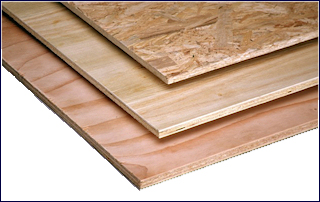Plywood & OSB
A large percentage of geodesic domes are constructed of timber for use as building greenhouses, homes, shelters of various kinds. Made with 2″ X 4″ , 2″ X 6″, 2″ X 8″ struts, timber domes with plywood or OSB coverings are projects many people with decent woodworking skills can accomplish, at least on smaller domes.
And when it comes to building a geodesic dome home made of timber, many manufacturers are qualified to help you plan all phases of construction. So the bigger and more complex, the more hiring a professional is a great idea.
We are all aware of plywood sheeting in covering roofs, so this is not the focus of this page. What we will discuss here are the various types of plywood and the difference between plywood and OSB (oriented strand board).
Why use plywood or OSB? Are they as good as one another?
Plywood offers a very strong and proven covering solution for a dome. As you may guess, plywood sheeting is mainly for timber-framed dome. Plywood is made from thin sheets of veneer that are peeled off a log. Picture a giant pencil sharpener. These sheets are laminated together in a hot press to make plywood.
Most timber dome builders frown on using OSB. They are partially correct. OSB requires that the cut edges be re-sealed to maintain their moisture proofing properties. Some attempt to associate OSB to particle board (a.k.a. aspenite) because they have a similar look, but they are very different. There is a certain amount of snobism involved here. When plywood was introduced as an alternative to solid wood sheets there was a large number of critics claiming plywood was not as good.
OSB is made from wood ground into thin wood strands. These strands are mixed with wax and adhesive and then hot pressed. Approximately 50 layers of strands make one sheet of OSB.
Building codes use the term “wood structural panel” to describe the use of plywood and OSB. Codes consider these two materials as the same. Both share a similar process of compressing and gluing small scrap pieces of wood together.
Advantages & disadvantages of OSB
OSB has some advantages over plywood:
- OSB is generally more square and has smaller dimensional tolerances
- It can be manufactured into panels of up to 8′ x 24′
- No soft spots such as there are in plywood
- OSB has greater shear strength than plywood; the span rating, nail pull and screw hold are all roughly the same
- Its cost can be half of plywood
- Greater waterproof characteristics
- When OSB is exposed to significant amounts of water or moisture, edges can expand by up to 15%, expecially on cut edges (which is why cuts are usually treated with a sealant)
Summary of plywood sheeting grades
Roofing for geodesic domes can be done with plywood with just one smooth side, also known as CDX plywood. CDX is not a grade, it’s a description of the plywood properties. CDX plywood is not exterior plywood; it requires to be covered.
“C” signifies that one side of the board is a C grade, the average surface quality you normally find at hardware outlets.
“D” means the other side of the board is a D grade, meaning it will have some slight depreciations or holes.
“X” = stands for the glue type used in making the board. X stands for ” Exposure to Moisture”. This grade can withstand exposure to moisture for a certain amount of time during the construction phase but does not mean it is weatherproof.
Other grades such as AAX, ABX or ACX plywood are available but not necessary when covering your geodesic dome: these are higher quality finish which are not needed for covering.




